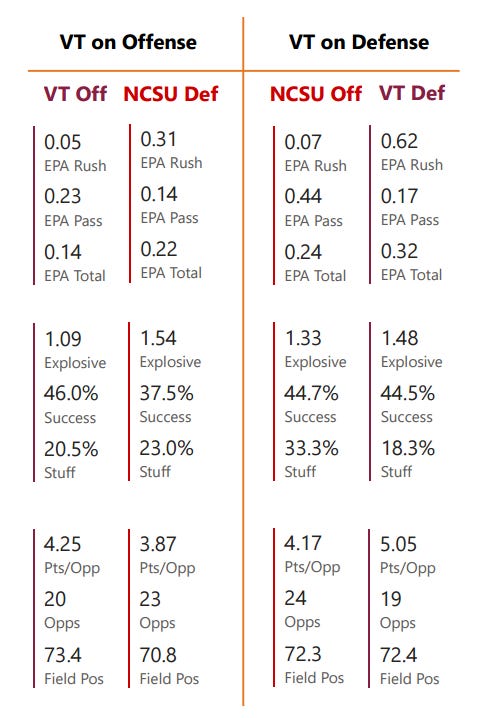It is not until the fifth game each season that the numbers become believable.
By that time, the Hokies, as well as most other college football teams, have played at least one good team, one bad team, and one mediocre team.
There are also at least 200 snaps that have been played on both offense and defense, which provides some statistical power to back up the story the numbers tell.
This season is different, or is it?
On the one hand, the Hokies that play on Saturday night at NC State have not played a football game this season, not as a post-Brent Pry, post opt-out team.
On the other hand, was Pry’s impact on gameday really that great? Is losing the players that have departed really that much different than when players get injured?
The optimistic case is the following:
The offensive line appears to be getting healthier, and it was injuries upfront that originally set the tailspin in motion
Losing uncommitted players is addition by subtraction
Philip Montgomery is a better head coach than Brent Pry, especially on game day
The pessimistic case says:
The defense is getting Covid-era thin at some positions (think 2020 North Carolina game at Edge and linebacker)
If the players are half as dejected as the fans, the fight they put up from here on out will be minimal
This team wasn’t even that good to begin with
Perhaps some numbers can help make sense of what is likely to transpire tonight at Carter-Finley Stadium in Raleigh.
When the Hokies have the ball
First off, these teams are closer in terms of on-field potential than one might expect based on their records. NC State enters with an ELO of 1494, putting them just slightly below average in FBS. The Hokies, meanwhile, carry a 1449 ELO.
Translation: NC State is better, but maybe by a field goal on a neutral field, if you average out 10 such results. At home at night, the Wolfpack are probably about a touchdown better than the Hokies.
But that is all in the aggregate, and it considers hypothetical matchups in which the present remains the present throughout the entire game, i.e., nobody gets hurt and nobody emerges as a major factor.
NC State’s defense appears poised to make Tech’s offense look good, on the ground at least.
The Wolfpack are decent enough defending the pass to hold Kyron Drones to an average performance. Think something in the neighborhood of 60% completion, 200 yards, 1 TD and 1 INT.
Those yards, however, are likely to come on big, chunk plays. With the Hokies playing on the road against a team that struggles to stop the run, expect to see a healthy dose of Tech’s stable of running backs.
Forty carries for 200+ yards is very possible, and would probably result in a Virginia Tech win.
Here’s something else to keep in mind. As anemic as Tech’s offense has looked at times, the Hokies actually score more points on average when they cross the opponent’s 40 yard-line than NC State does.
The Hokies are also successful on 46% of their offensive plays, which is two percentage points better than the Wolfpack.
Where Virginia Tech has struggled is the lack of explosiveness on offense, and that is precisely what NC State’s defense appears set to rectify.
When NC State has the ball
As a team, NC State does not run the ball very well. An EPA/play of 0.07 on runs isn’t awful, but it’s not that much better than Tech’s 0.05.
If Sam Siefkes can successfully scheme against Hollywood Smothers (e.g., make Bailey keep the ball on options, stack the box, etc.), the Hokies defense might be able to put up a fight.
However, Virginia Tech’s 0.62 EPA/play allowed on runs is absolutely atrocious. Most likely, NC State will run the ball at will against the Hokies.
Another possibility is that Siefkes might sell out on offense to try to get NC State into second-and-long. NC State allows a surprisingly astronomic 33.3% stuff rate.
If Virginia Tech can consistently stuff first down runs, then the Wolfpack might be baited into throwing on second- and third-down.
Such a situation may or may not benefit Tech. The Hokies are getting thin in the secondary, and NC State quarterback CJ Bailey has put up huge numbers this season.
He will turn the ball over, though.
Again, the key appears to be pressure. Expect Siefkes to send extra rushers more frequently than Tech has shown through four games this season.
Overall
The Hokies are 0-0 in conference play. Florida St. lost at Virginia last night, and Clemson has two losses in conference (three overall). The ACC is wide open.
Many Virginia Tech players have a ton to play for. Seniors can improve their draft prospects. Underclassmen all have financial, and possibly transfer portal, considerations that should spur them to play hard.
Likewise, the coaches are all trying to put a good product on the field in order to improve their chances of landing a good job next year.
And at the top, no one has more on the line than Philip Montgomery. A 6-2 conference record (obviously very unlikely) would make him Virginia Tech’s coach in 2026. Even five wins might be good enough to get that interim tag removed.
Four wins would get him a P4 coordinator job or a shot at a G5 head coaching opportunity.
Two to three wins would give him a shot at a G5 coordinator gig.
Anything less, and he’s probably done coaching college football.
Tonight we will find out what has truly been lost in 2025, and what is still out there to be gained.



